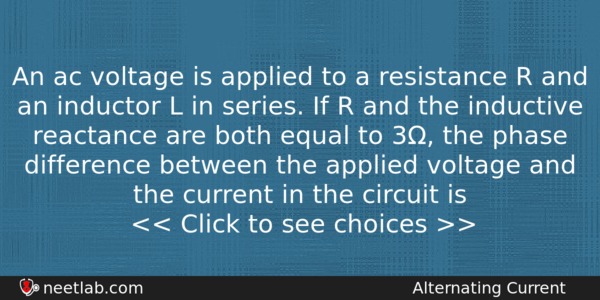| ⇦ | 
| ⇨ |
An ac voltage is applied to a resistance R and an inductor L in series. If R and the inductive reactance are both equal to 3Ω, the phase difference between the applied voltage and the current in the circuit is
Options
(a) π/6
(b) π/4
(c) π/2
(d) zero
Correct Answer:
π/4
Explanation:
The phase difference is given by
tan ? = Xₗ / R = 3/3 = 1
? = π/4
Related Questions: - Solar radiation is
- A nuclear reaction is given as 4 ₁H¹→₂He⁴+₀e¹+energy Mention the type of reaction.
- A rectangular copper coil is placed in a uniform magnetic field of induction 40 mT
- The upper half of an inclined plane of inclination θ is perfectly smooth while lower
- In photoelectric effect, the photoelectric current
Topics: Alternating Current
(96)
Subject: Physics
(2479)
Important MCQs Based on Medical Entrance Examinations To Improve Your NEET Score
- Solar radiation is
- A nuclear reaction is given as 4 ₁H¹→₂He⁴+₀e¹+energy Mention the type of reaction.
- A rectangular copper coil is placed in a uniform magnetic field of induction 40 mT
- The upper half of an inclined plane of inclination θ is perfectly smooth while lower
- In photoelectric effect, the photoelectric current
Topics: Alternating Current (96)
Subject: Physics (2479)
Important MCQs Based on Medical Entrance Examinations To Improve Your NEET Score
18000+ students are using NEETLab to improve their score. What about you?
Solve Previous Year MCQs, Mock Tests, Topicwise Practice Tests, Identify Weak Topics, Formula Flash cards and much more is available in NEETLab Android App to improve your NEET score.
Share this page with your friends

Leave a Reply